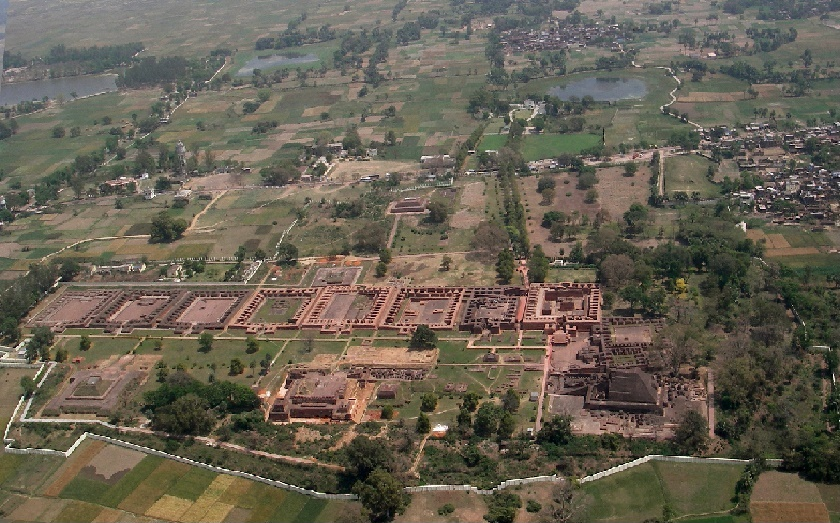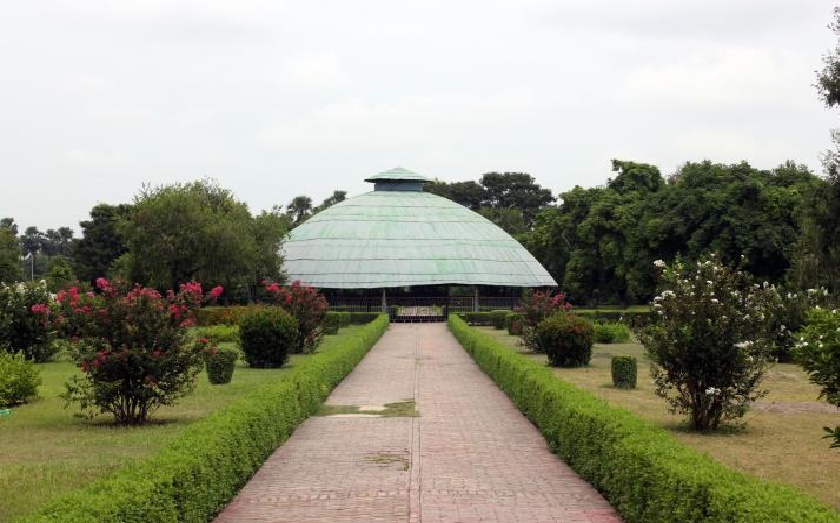Bihar
Nalanda Mahavihar
The archaeological site of Nalanda is located about 15 kms south of Biharsharif the district headquarter of Nalanda and about 95 kms south- east of Patna, the capital of Bihar state, well connected by rail and road.
Biharsharif the district headquarter of Nalanda and about 95 kms south- east of Patna, the capital of Bihar state, well connected by rail and road.
History of Nalanda goes back to the days of Mahavira and Buddha in the 6th Century BCE. It was the place of birth and nirvana of Sariputta, one of the most famous disciples of Buddha. But the place rose into prominence in 5th Century CE as a great monastic-cum-educational institution for oriental art and learning in the whole Buddhist world attracting students from distant countries including Hiuen Tsiang and I-Tsing from China. Various subjects like theology, grammar, logic, astronomy, metaphysics and philosophy were taught here. The institution was maintained by the revenue collected from the villages bestowed specifically for the purpose by the contemporary rulers as evident from inscriptions.
Nalanda Mahavihara, regarded as one of the greatest universities of ancient world, was founded by Kumaragupta I (CE 413-455) of the great Gupta dynasty. King Harshavardhana of Kannauj (CE 606-647) and the Pala kings of east India (8th-12th Century CE) continued to extend patronage to this centre. The decline of this great institution started in later Pala period but the final blow came in around CE 1200 by the invasion of Bakhtiyar Khalji who destroyed it by fire and the glory of Nalanda thus got burried under the soil.
Excavations conducted by Archaeological Survey of India during 1915-37 and 1974-82 have exposed the extensive remains of six major brick temples and eleven monasteries arranged on a systematic layout and spread over an area of more than a square kilometre. Basically a hundred feet wide passage runs north-south with the row of temples on the west and that of the monasteries on the east of it.
The monasteries are quite identical in general layout and appearance. Central courtyard, row of cells all around with a common verandah, a secret chamber for keeping valuables, staircase for going to upper stories, kitchen, well, granary, single entrance and common place for prayer or meeting etc. are some characteristic features of almost all the monasteries at Nalanda. The main Temple Site 3 in panchayatan style is the largest and most imposing structure at southern extremity of the row of temples and is surrounded by votive stupas. Originally it had four corner towers out of which two are in existence and decorated with rows of niches containing beautiful stucco images of Buddha and Bodhisattvas which are fine specimens of Gupta art. A temple different in character and not conforming to the general lay-out of the remains is represented by Temple Site 2. The interesting feature of this temple is the dado of two hundred and eleven sculptured panels over the moulded plinth. Another mound called 'Sarai Tila' very close to the monastery complex has revealed ruins of a temple with murals and feet portion of a colossal stucco image of Lord Buddha.Other than structures, the excavations have unearthed many sculptures and images in stone, bronze and stucco. Significant among the Buddhist sculptures are Buddha in different postures, Avalokitesvara, Manjusri, Tara, Prajnaparamita, Marichi, Jambhala etc and a few images are of Brahmanical deities like Vishnu, Siva-Parvati, Mahishasura-mardini, Ganesa, Surya etc. Other noteworthy discoveries of excavations include the murals, copper plates, inscriptions, sealings, plaques, coins, terracottas, potteries etc. The antiquities have been exhibited for the visitors in the site museum maintained by the Archaeological Survey of India.
Relic Stupa Vaishali / Kolhua
This is one among the eight relic stupas built over the corporeal remains of Buddha. The remains were distributed among eight claimants, one being the Lichchavis of Vaishali. Inner most stupa of smaller dimension, measuring 8.07 m. in diameter is assignable to circa fifth Century B.C. During the rule of the Mauryans and later under Sungas and Kushanas the stupa was successively enlarged by brick encasing and by raising the plinth and height of the structure. The excavation have yielded a number of antiquities among which the relic casket containing ashes mixed with earth, a punch marked coin, some beads and gold objects are the most remarkable discovery.
of Buddha. The remains were distributed among eight claimants, one being the Lichchavis of Vaishali. Inner most stupa of smaller dimension, measuring 8.07 m. in diameter is assignable to circa fifth Century B.C. During the rule of the Mauryans and later under Sungas and Kushanas the stupa was successively enlarged by brick encasing and by raising the plinth and height of the structure. The excavation have yielded a number of antiquities among which the relic casket containing ashes mixed with earth, a punch marked coin, some beads and gold objects are the most remarkable discovery.
Source: Must See Indian Heritage
Last Modified : 7/1/2020
This topic provides information about Must see her...
This topic provides information about Must see her...
This page covers the places to visit in Tamilnadu.
This topic provides information about Must see her...
